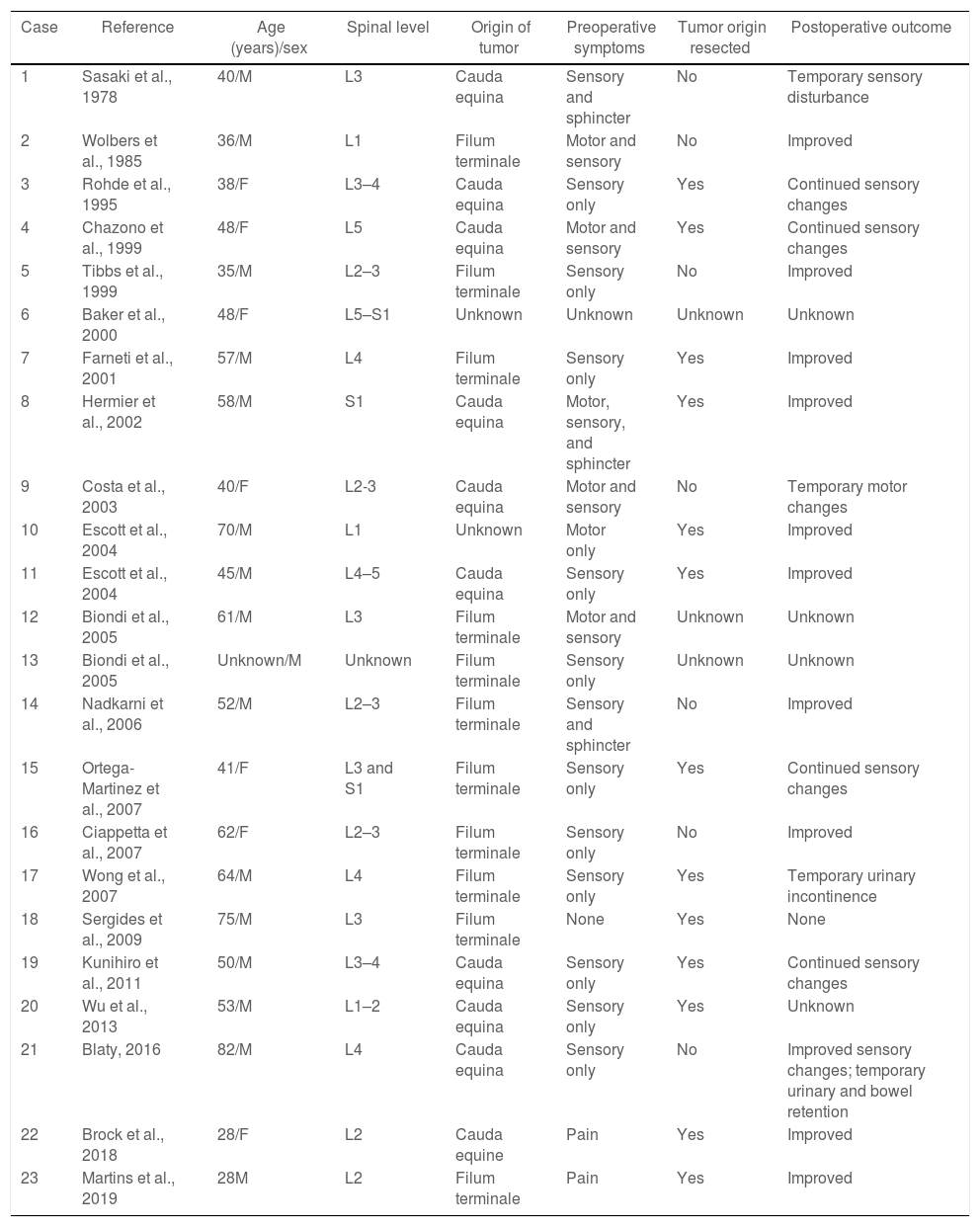Hemangioblastomas are rare lesions accounting for 1–5% of all spinal cord tumors and are mostly associated with von Hippel–Lindau syndrome. Localization in the cauda equina is uncommon. In this manuscript we aim to describe a rare case of sporadic intradural extramedullary hemangioblastoma of the cauda equina and present a literature review. A systematic research was performed on Pubmed, MEDLINE, and Google Scholar, using as keywords “spinal hemangioblastoma” and “cauda equina tumors”. The previous literature is integrated by the description of the present case. A 49 year-old female, presented on August 2020 to our institution suffering from claudication neurogena, right sciatica and paraesthesia in right L5 radicular dermatome for more than 3 months. Neurological examination revealed hypoesthesia on right L5 dermatome and weakness of right anterior tibialis muscle. An MRI which showed an intradural mass at L1/2 level and an angiography that showing a nidus of serpiginous vessels inside the lesion. Microsurgical en bloc resection of lesion was performed with adjuvant neurophisological intra operative monitorings. Histological examination provided the diagnosis of hemangioblastoma. After surgery symptoms and neurological impairment gradually improved. A 10 months post-operative MRI showed no residual tumor. Although intradural extramedullary hemangioblastoma of the cauda equina without von Hippel–Lindau syndrome it is a rare pathological entity, this diagnosis must be taken in for cauda equina masses. Preoperative embolization is an option to minimize intraoperative bleeding. Radiosurgery seems to prevent recurrences when the tumor is not completely excised. Complete surgical removal of the lesion is usually possible and lead to a low likelihood of recurrence.
Los hemangioblastomas son lesiones raras que representan del 1 al 5% de todos los tumores de la médula espinal y se asocian principalmente al síndrome de von Hippel-Lindau. La localización en la cauda equine es infrecuente. En este manuscrito nuestro objetivo es describir un caso raro de hemangioblastoma intradural extramedular esporádico de la cauda equina y presentar una revisión de la literatura. Se realizó una bùsqueda sistemática en Pubmed, MEDLINE y Google Scholar, utilizando como palabras clave «spinal hemangioblastoma» y «cauda equina tumors». Presentamos el caso clínico y se discute, y se compara con la literatura previamente publicada al respecto. Mujer de 49 años, se presentó en agosto del 2020 a nuestra institución. Los síntomas fueron claudicatio neurogena, ciática derecha y parestesia en dermatoma radicular L5 derecho durante más de 3 meses. El examen neurológico reveló hipoestesia en el dermatoma L5 derecho y debilidad del músculo tibial anterior derecho. La resonancia magnética mostró una masa intradural a nivel L1/2 y la angiografía mostró un nido de vasos serpiginosos dentro de la lesión. Se realizó una resección microquirúrgica en bloque de la lesión con monitorización intraoperatoria neurofisiológica adyuvante. El examen histológico proporcionó el diagnóstico de hemangioblastoma. Después de la cirugía, los síntomas y el deterioro neurológico mejoraron gradualmente. Una resonancia magnética 10 meses después de la operación no mostró tumor residual. Aunque el hemangioblastoma intradural extramedular de la cauda equine sin síndrome de von Hippel-Lindau es una entidad patológica poco frecuente, este diagnóstico debe tenerse en cuenta cuando una masa afecta a la cola de caballo. La embolización preoperatoria es una opción para minimizar el sangrado intraoperatorio. La radiocirugía parece prevenir las recurrencias cuando el tumor no se extirpa por completo. La extirpación quirúrgica completa de la lesión suele ser posible y parece factible conducir a una baja probabilidad de recurrencia.
Article

If it is the first time you have accessed you can obtain your credentials by contacting Elsevier Spain in suscripciones@elsevier.com or by calling our Customer Service at902 88 87 40 if you are calling from Spain or at +34 932 418 800 (from 9 to 18h., GMT + 1) if you are calling outside of Spain.
If you already have your login data, please click here .
If you have forgotten your password you can you can recover it by clicking here and selecting the option ¿I have forgotten my password¿.










